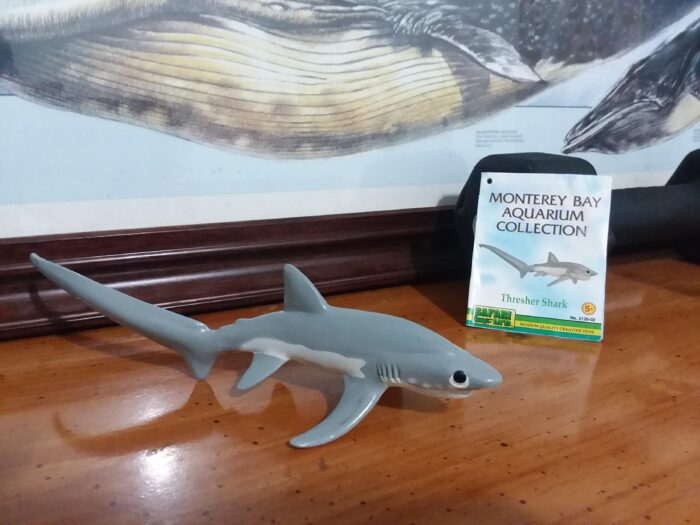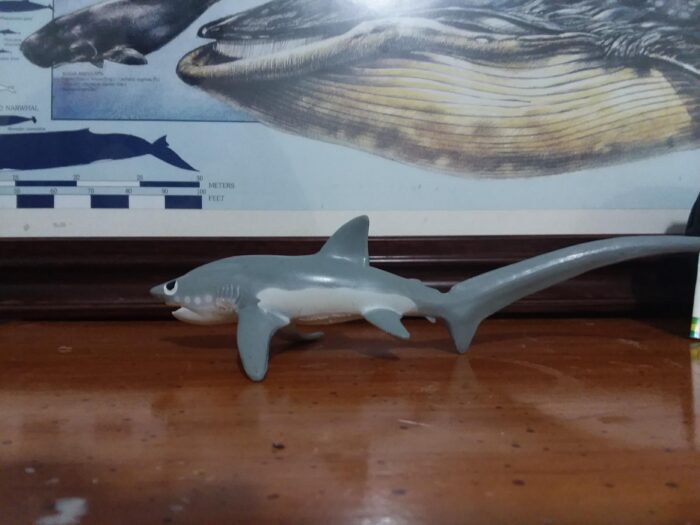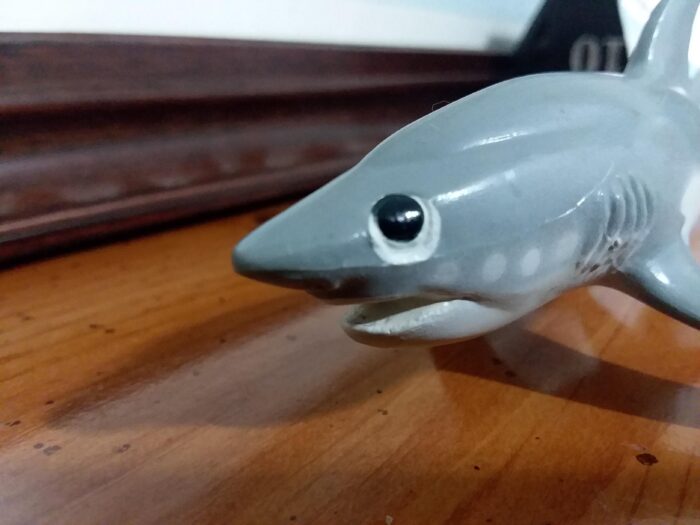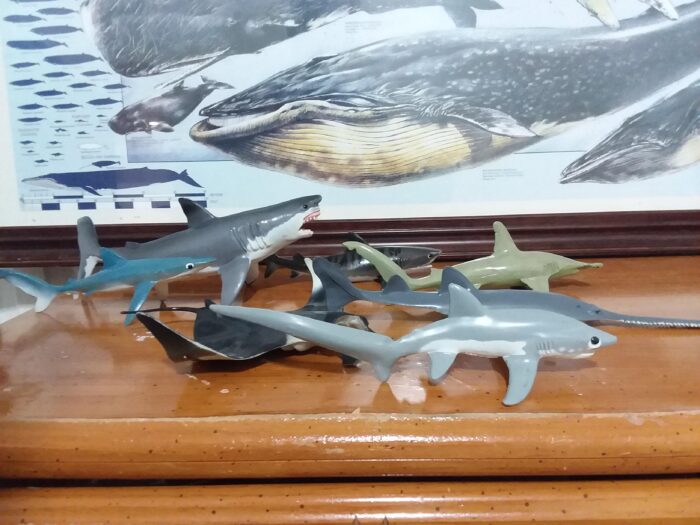Of the three species of thresher shark, the biggest outlier appears to be the bigeye thresher (Alopias superciliosus). The bigeye thresher and its close relatives belong to the order of mackerel sharks, Lamniformes. The bigeye thresher is found in tropical waters all across the world. This species inhabits deeper waters than its relatives, spending the day avoiding predators at depths of 300-500m and moving to the surface during the nighttime to hunt for prey. Bigeye threshers are intermediate in size to the other threshers, ranging from 3.3-4.0 meters at 160 kilograms with a maximum of 4.9 meters and 364 kilograms. While not endangered, the bigeye thresher is classified as ”Vulnerable” by the IUCN along with the rest of its genus due to the threat of overexploitation as a game fish. Even though the prey-pursuing and breaching behavior of other thresher sharks have characterized the genus as fast swimmers, this behavior has never been directly observed by the bigeye thresher. A recent study confirmed that the bigeye thresher’s stiff tail and skin morphology is consistent with the observations of it being a slow-swimming shark. The bigeye thresher uses its caudal fin to ambush-hunt its prey which includes squid, mackerel, lancetfish, billfish, and hake. The bigeye thresher’s predators are expected to include larger sharks and marine mammals.
Today marks another review from the Monterey Bay Aquarium Collection, Safari Ltd’s line of scaled marine animals produced in collaboration with the experts from the titular institution. The bigeye thresher is one of the later additions to the collection, released back in 1996. As far as my research on the toy animal wiki and eBay can elucidate, this is the only figure produced of this particular species. Since its release, the only other notable thresher shark figure of note is the Safari Sealife thresher shark. Therefore, a lot of pressure rides on this figure’s quality.

The thresher shark measures about 21.2cm. At its marketed scale of 1:20, this corresponds to 4.24 meters, but it can fit the 1:16-1:23 range. The imprint just says ”Thresher shark”, but the really neat info tag does specify it as A.superciliosus. This is reflected well in its appearance. Based on the references I can find, the slender shape of the body, the placement of the fins, the size of the caudal fin, and the number of gill slits are all correct (which really should be a simple thing to get right, but companies prove otherwise).

In addition to the paintjob, impressions are sculpted for the eyes. I’ve made comments regarding the overly-exaggerated eyes in the whale shark and narwhal, but this time, it works to the benefit of the bigeye thresher. Their eyes are analogous to those of giant squids, as they are both adapted for very dark deep waters. You can also notice the eyebrow-like groove along the width of the head, where the species name ”superciliosus” derives from. The mouth is moderately agape and lacks teeth, as per usual when it comes to a lot of the open-mouth figures from the MBA line.

The tail is very long, at about 9.8cm, it takes up nearly half of the shark’s length. This is accurate to this species.

Underneath, we can view the underside, and the lack of claspers indicates this figure is anatomically female, which is appropriate given the size of the figure at its marketed scale.

The paintjob is pretty straightforward. A light gray for the dorsal half and white for the ventral side. There’s a break in the countershading, where the pelvic fin’s gray coloring is discontinuous with the rest gray on the body. This detail is present on the actual photos of bigeye threshers I’ve come across. The shade of gray isn’t conspicuously inaccurate, but a slightly dark or more bluish gray may have been more realistic. There are 4 white spots between the eye and the gill slits, which I don’t see a lot, even in photos. Not sure if this was just some stylistic detail or if this trait exists within the intraspecific variation of bigeye threshers.

The MBA thresher shark is definitely a very good representation of this animal, especially given its rarity in the toy market. The only minor complaint I have is the persistent issue with open mouths in this line. Unfortunately, those who want this figure are put into a bad position. Not only has this figure been retired since 2009, but since it was a later release within this line, it had a short lifespan compared to other retirees. This means that not many were produced over its lifetime and is consequently among the rarest figures to find in the secondhand market, second only to certain calves and the Pacific-white-sided dolphin. For those who don’t want to become eBay-sentinels, I’d point you towards the Safari Sea Life pelagic thresher.
Disclaimer: links to Ebay and Amazon on the AnimalToyBlog are affiliate links, so we make a small commission if you use them. Thanks for supporting us!




i didn’t realize this was a different figure from the current Safari thresher shark. I assumed it was just a reissue.
If you know, how does the size compare with the Safari pelagic thresher?
I don’t know precisely. Luckily, I did just order the pelagic thresher and it should be on its way. I’ll post it in my non-Cetacean collection thread.